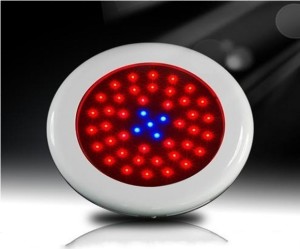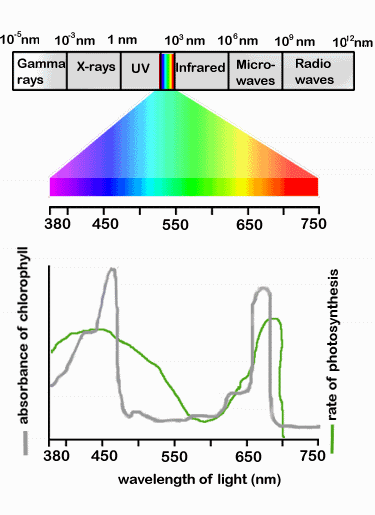 What is the difference between RED and BLUE spectrum light for plants?
What is the difference between RED and BLUE spectrum light for plants?
WHITE/ BLUE spectrum light is more suited for propagating and is more for the early stages of plant growth (vegetative phase). RED spectrum light is required more when your plants are flowering and fruiting (blooming phase).
What is the ideal RED BLUE ratio?
Based on our experience, we have noted the 8:2 & 7:3 is proven for Lettuce, 7:3 & 6:4 is proven for Pepper, 9:1 & 8:2 is proven for Strawberry.
Below Chart shows the absorption rate of CHLOROPHYLL & the rate of PHOTOSYNTHESIS.
For more details, visit LEDprincess
============================================================
LEDs Shine in Bedding Plant Production Study
Previously, the only way for producers to substantially increase ambient greenhouse was to provide supplemental lighting from high-intensity discharge lights–most commonly high-pressure sodium (HPS) lamps. HPS lamps have drawbacks, however; they are only about 25% to 30% efficient, and have limited lifespans. Another disadvantage is the high levels of radiant heat energy produced by high-pressure sodium lamps; up to 75% of the energy from HPS lamps that is not converted to light is emitted as radiant heat energy, causing the surface of the lamps to reach temperatures as high as 450°C. To prevent leaves from scorching from exposure to the high heat, plants must be separated from the HPS lamps.
Light-emitting diodes (LEDs) can offer growers benefits such as higher energy efficiencies and a longer operating life. To determine whether the use of narrow-spectra high-intensity LEDs is can be a practicable supplemental lighting source for greenhouse grown annual bedding plant seedlings, researchers Wesley Randall and Roberto Lopez from Purdue University designed a series of lighting experiments on plugs of Antirrhinum, Catharanthus, Celosia, Impatiens, Pelargonium, Petunia, Tagetes, Salvia, and Viola.
Results showed that the height of Catharanthus, Celosia, Impatiens, Petunia, Tagetes, Salvia, and Viola was 31%, 29%, 31%, 55%, 20%, 9%, and 35% shorter, respectively, for seedlings grown under 85:15 red:blue LEDs compared with those grown under high-pressure sodium lamps. Stem caliper of Antirrhinum, Pelargonium, and Tagetes was 16%, 8%, and 13% larger, respectively, for seedlings grown under the 85:15 red:blue LEDs compared with seedlings grown under HPS lamps. The quality index was significantly higher for Petunia, Salvia, and Viola under 85:15, 70:30, and 100:0 red:blue LEDs than under HPS lamps, respectively. Overall, the results indicate that seedling quality for the majority of the species tested under supplemental light LEDs providing both red and blue light was similar or higher than those grown under high-pressure sodium lamps.
“Our results indicate that providing supplemental lighting from LEDs or high-pressure sodium lamps has a positive influence on seedling root dry mass, height, and stem caliper leading to high-quality bedding plant seedlings when solar light is limited,” Lopez and Randall noted. “A light ratio of 85:15 red:blue light could be a good combination for greenhouse LED supplemental lighting of bedding plant plugs. However, it is important to remember that although blue LEDs have a higher electrical conversion efficiency compared with red LEDs, blue light is a higher energy light, which increases energy consumption as higher proportions of blue are used.”
In the life cycle of plants, most developmental processes are dependent on light. Significant biological processes such as germination, shade avoidance, circadian rhythms, and flower induction are all affected by light. Recent advancements in the use of LED lighting in plant and vegetable production systems has researchers looking for insights into the effects of these artificial lights on the growth and yield of crops. Scientists from the Department of Horticultural Science at Chungbuk National University published a study in HortScience that sheds some light on the advantages and challenges of LEDs in lettuce cultivation.
The increased use of LEDs in environmentally controlled closed-type plant production systems allows crop production throughout the year, regardless of external weather conditions. According to authors Ki-Ho Son and Myung-Min Oh, LEDs have some advantages over traditional lighting sources in plant cultivation. “LEDs have the advantages of high light-conversion efficiency with low radiant heat output, semipermanence, and small mass,” they noted. “In addition, LEDs are available in a variety of narrow wavebands; hence, it is possible to optimize light quality to improve both crop yield and quality.” They explained that blue and red LEDs are usually used for plant growth because chlorophyll a and b efficiently absorb wavelengths in the blue and red ranges.
The research design used red and green leaf lettuce subjected to six LED lighting treatments. The scientists examined growth characteristics including the fresh and dry weights of shoots and roots, shoot-to-root ratio, total leaf area, and chlorophyll content. Chlorophyll fluorescence, antioxidant capacity, phenolic concentration, and flavonoid concentration were also measured in the study. “The growth characteristic results for the two lettuce cultivars grown under various ratios of blue to red LEDs confirmed that red LED serves as a major light source that improves lettuce growth rate,” the authors said.
The experiments confirmed that both blue and red LEDs have a positive effect on the accumulation of antioxidant phenolic compounds and lettuce growth, respectively. “Red light irradiation in the absence of blue light was effective at stimulating the biomass accumulation of lettuce plants; however, this lighting alone induced abnormal leaf shape and had a negative effect on polyphenolics and antioxidant levels,” the scientists said. They recommended a mixture of blue and red LEDs to enhance lettuce crop quality and yield in closed-type plant production systems.
